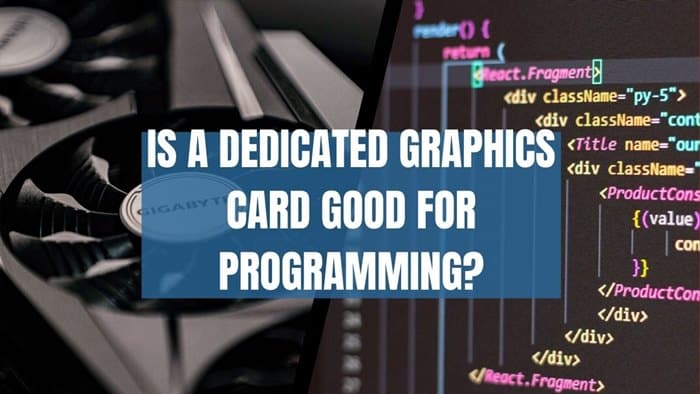The Graphics card, also known as GPU or video card is responsible for rendering images to the display. A GPU in a laptop or PC is an essential component for displaying images on the screen. Additionally, it also frees your processor from the unwanted loads to perform the tasks.
Knowing if you require a dedicated graphics card for programming depends upon the sort of programming you are doing. Usually, normal coding won’t require a dedicated graphics card due to an integrated graphics card already present in your laptop/PC. However, if you are working with some specific kind of programming such as game development, you may need to use a dedicated graphics card.
Also, you will see benefits with a dedicated graphics card if the development needs the use of emulators. For example, the Android Studio may run perfectly without any dedicated graphics card just with a decent CPU and the required amount of RAM. But, if you can invest in a graphics card, the emulation tasks will get much smoother.
So, it is just like having another advantage when it comes to the graphical tasks in your programming works. In general, the graphics card is not needed regardless of the programming language you use.

What Is a Dedicated Graphics Card? How Is It Different From Integrated Graphics Card?
GPUs are generally of two types, integrated graphics cards, and dedicated graphics cards. Dedicated graphic cards sometimes known as discrete video cards are installed to manage the overall graphics performance of the computer.
To be precise, A dedicated graphics card is a completely separate processor other than the CPU and has its own RAM (called VRAM). The dedicated graphics card comes with a processor, a small amount of RAM, VRM, PCB, connectors, and a cooling fan. The dedicated graphics cards are expected to deliver better performance when dealing with video editing or intense gameplay sessions.
Dedicated graphics cards can be found both on laptops and desktops.
When using a dedicated graphics card you will require an equally powerful processor to evenly distribute the load between the two. A discrete graphic card uses more power, resulting in bigger electricity bills and decreased energy efficiency of your laptop
The integrated graphics card on the other hand has a share of power between the processor and the video card. The integrated graphics card is directly built on the processor of a computer. The applications of integrated graphics cards can be seen in normal computer tasks such as surfing on the internet, typical office jobs, editing documents, light-weight coding, etc.
The modern-day integrated graphics cards are capable enough to play intermediate games and perform other tasks such as coding, Photo editing, video conferences, etc. The latest integrated graphics card uses both processor and GPU on the same die for maximized performance.
Key Differences Between Dedicated Graphics and Integrated Graphic Card
| Dedicated Graphics Card | Integrated Graphics Card |
|---|---|
| Dedicated graphics cards have their own memory and processor | An integrated graphics card that utilizes system memory and a system processor. |
| Consume more electricity and are highly-priced | Works fine with normal power and is present in all PCs from the manufacturer |
| Dedicated graphics Maximize the performance of your system | Can create issues when doing high-end tasks such as rendering images. |
| Useful when coding for high-end games | Can work fine with normal gaming but can face issues when programming for graphical applications. |
Also Read: Does Graphics Card Brand matter?
Is Dedicated Graphics Card Required For Programming?
Whether you require a dedicated graphics card for your programming purposes is subjective to the nature of programming you are working with. A normal coding project with a default console might not require a dedicated graphics card. If you are using the latest integrated graphics card there is no need to spend money on a dedicated graphics card for programming only. However, when you are developing a gaming application that involves high-end graphics and the use of emulators, then buying a dedicated video card for programing is suggested.
Since an Integrated graphic card shares the memory with your processor, it might create issues while testing and developing the applications. The coding languages that do not require 3d rendering such as python, C, Java, etc won’t demand your PC a dedicated graphics card.
A dedicated graphics card should be there when your day-to-day tasks are to work with applications such as Unity 3D, and Unreal Engine4 as they use complex animations and 3D models. If you are developing an application that would largely rely on the graphics card for functioning, then a dedicated graphics card is a must for a programming project.
Normally, a CPU is responsible for doing all the math related to programming and compiling them for execution by hardware. A Video card chip would help in processing the graphics and reduce the extra burden on the CPU. With advancements in technologies, the latest CPUs are already equipped with an integrated GPU that handles all the tasks related to graphics at intermediate levels. So, a dedicated GPU is not required for programming unless directed.
An ideal PC for programming should have a healthy processor(i5 or more), Enough Ram(8GB minimum), an SSD(128GB or more) for faster processing, and a GPU depending upon the nature of the programming.
How Much RAM Is Required For a Programming Laptop?
For a programming language, 8GB RAM should suffice all levels of programming. RAM, however, is not wholly responsible for programming on the laptop. So a powerful RAM and an SSD should suffice the requirements.
Being a student If you are going to buy a new laptop for programming purposes, and are confused between a Dedicated or Integrated graphics card then I would suggest you opt for a laptop with the dedicated graphics card as the nature of work will surely go up and you might feel the absence of a dedicated graphics card.
How can a dedicated graphics card facilitate programming?
Well, there is nearly nothing that a graphics card can help you with when it comes to programming. However, in some kinds of programming, you may need to make use of the graphical power in your computer.
As we discussed earlier, this may happen when it comes to game and mobile application developments.
It is true that a good CPU with integrated graphics can handle all those tasks but a dedicated graphics card will definitely take away some load from your CPU. So, it is always good to have dedicated graphics but not crucial.
Another thing is that a graphics card may help you with other things such as animations, emulations, graphics designing, and video editing which are some skills used by a lot of programmers.
Can I Upgrade My Laptop Graphics Card?
No, the graphics card on laptops cannot be upgraded as the GPU is soldered on the motherboard, and upgrading it can damage other components of the laptop. However, there is an option available, that you can make use of graphic card docks, that help you use a graphic card externally.
You easily upgrade your Graphics card on the desktop by replacing the old GPU with new in the PCIe slots.
The Conclusion
As of now, you might be clear about the requirement of dedicated graphics cards for programming. We talked about the differences between dedicated and integrated graphics cards and how they impact the performance of your device. The coding languages such as Python, Java, C, C++, or IDEs won’t ask your laptop for a dedicated graphics card. The gaming design projects and other applications such as drawing apps would require a dedicated graphics card.
I hope you loved reading this article. Don’t forget to share it with your friends.

I am Anshul Rana, an experienced author specializing in PC gear reviews and Windows 10 software tutorials. With a strong passion for technology and an in-depth understanding of the PC industry, I provide insightful and detailed analyses of computer peripherals, gaming gear, and software solutions. My writing style is concise yet informative, making complex topics accessible to both beginners and advanced users. Through my reviews and tutorials, I aim to offer valuable guidance, helping readers make informed decisions to enhance their PC experience and explore the vast possibilities of Windows 10 software.









